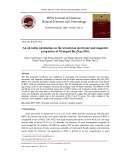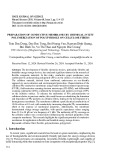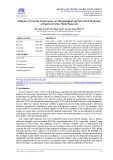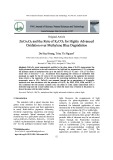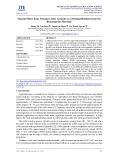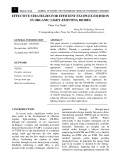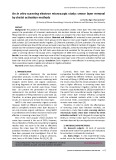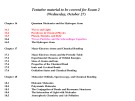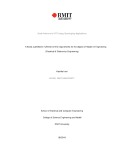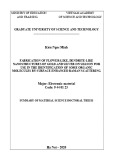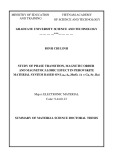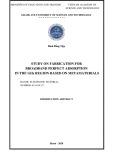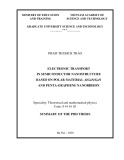
Electronic materials
-
In this study, a composite material between MnFe2O4 and activated carbon from coffee husks (MFO/AC) was synthesized using co-precipitate and hydrothermal methods to remove ammonium from aqueous solutions. The characteristics of MFO/AC were characterized and evaluated by scanning electron microscopy (SEM) and Fourier transform infrared spectra (FTIR).
 9p
9p  vijiraiya
vijiraiya
 19-05-2025
19-05-2025
 2
2
 1
1
 Download
Download
-
This article explores practical research on the application of SEC in mathematics education both globally and in Vietnam. It examines the perspectives and characteristics of SEC in mathematics education, as well as SEC integrated with AI.
 17p
17p  viaburame
viaburame
 14-03-2025
14-03-2025
 3
3
 1
1
 Download
Download
-
The first principle calculation was employed to investigate the formation energies and structural, electronic, and magnetic properties of intrinsic and Ni-doped sodium bismuth titanate Bi0.5Na0.5TiO3(BNT). The obtained formation energies indicate that Ni atoms prefer to dope into Bi-sites in the lattice of BNT while the calculated band structure shows that the doping leads to the emergence of new midgap energy states in the bandgaps, reducing the bandgap value of doped materials.
 10p
10p  viaburame
viaburame
 14-03-2025
14-03-2025
 3
3
 1
1
 Download
Download
-
The development of flexible electronic devices, particularly flexible and bendable energy storage devices, has catalyzed significant interest in the research of flexible composite materials. In this study, conductive paper membranes were synthesized by polymerizing polypyrrole (PPy) on the surface of cellulose fibers.
 14p
14p  viaburame
viaburame
 14-03-2025
14-03-2025
 5
5
 1
1
 Download
Download
-
Zinc oxide is highly sought after for several applications in biology, optoelectronics, electronics, and sensing. Zinc oxide nanorods exhibit a high exciton binding energy and a wide direct band gap, making them an attractive material for ultraviolet optoelectronic devices in the compound semiconductor field.
 6p
6p  viling
viling
 11-10-2024
11-10-2024
 4
4
 1
1
 Download
Download
-
In this study, spinel ferrite nanoparticles CoFe2-xLaxO4 (x = 0, 0.025, and 0.05) were successfully synthesized via a simple co-precipitation method using a 5% NaOH solution as a precipitating agent. The physicochemical properties of the materials, annealed at 850 °C for one hour, were characterized using powder X-ray diffraction (PXRD), energy-dispersive X-ray spectroscopy (EDX), transmission electron microscopy (TEM), and vibrating-sample magnetometry (VSM) at room temperature.
 10p
10p  viling
viling
 11-10-2024
11-10-2024
 3
3
 1
1
 Download
Download
-
The materials with a spinel structure have gotten some attention for their resistance to oxidizing/reducing agents and their application in many fields such as pigments, refractory, electronic engineering, magnetism, and energy storage materials.
 8p
8p  vifilm
vifilm
 11-10-2024
11-10-2024
 2
2
 1
1
 Download
Download
-
This study aimed to extract cellulose fibers from coffee grounds using a non-toxic and cost-efficient alkaline hydrogen peroxide extraction method. Scanning electron microscopy (SEM) analysis results indicated that, after being dried, the cellulose fibers tended to aggregate into bundles, with no individual fibers observed.
 8p
8p  viinuzuka
viinuzuka
 28-02-2025
28-02-2025
 7
7
 1
1
 Download
Download
-
This paper presents a comprehensive investigation into the optimization of exciplex emission in organic light-emitting diodes (OLEDs). Through a systematic exploration of various combinations of hole-transporting materials (HTMs) and electron-transporting materials (ETMs), we elucidate critical factors influencing exciplex formation and its impact on OLED performance.
 5p
5p  viyamanaka
viyamanaka
 06-02-2025
06-02-2025
 4
4
 1
1
 Download
Download
-
The process of mechanical root canal preparation creates smear layer. The smear layer can prevent the penetration of intracanal medicaments into dentinal tubules and influence the adaptation of filling materials to canal walls. The purpose of this study is to compare the smear layer removal ability of root canal irrigation methods with chelat solution.
 6p
6p  viharuno
viharuno
 03-01-2025
03-01-2025
 11
11
 2
2
 Download
Download
-
Quantum Mechanics and the Hydrogen Atom, Many-Electron Atoms and Chemical Bonding, Molecular Orbitals, Spectroscopy, and Chemical Bonding,... as the main contents of the lesson lecture 9 "Tentative material to be covered for Exam 2". Invite you to consult the lesson for more documents serving the academic needs and research.
 38p
38p  nguyenphong201
nguyenphong201
 11-12-2015
11-12-2015
 45
45
 3
3
 Download
Download
-
The aim of this thesis is investigate and design a small antenna which can be embedded onto a Polyethylene substrate (used for making roof tiles). The antenna can be used to harvest ambient energy by connecting it to a rectifier. Due to the dimensional constraints of a roof tile as well as the materials used, there are limitations imposed on the antenna size, and thus the radiation efficiency and bandwidth often become a limiting factor in the overall performance of the system.
 93p
93p  runthenight04
runthenight04
 02-02-2023
02-02-2023
 21
21
 2
2
 Download
Download
-
The objective of this project was to develop \(Ti{O_2}\) based multifunctional substrates through silver decoration, while simultaneously enhancing the photocatalytic performance of \(Ti{O_2}\) in the substrate. Employing Ag nanoparticles introduced additional functionality to the system, namely surface-enhanced Raman scattering (SERS), thus enabling the detection of trace amounts of organic molecules prior to their degradation, all with the same substrate.
 123p
123p  runthenight04
runthenight04
 02-02-2023
02-02-2023
 11
11
 2
2
 Download
Download
-
Target of thesis: To develop a method that can simplify the determination of the thermodynamic parameters and XAFS spectra which base on the second-order cumulant only. In particular, this method can be applied for both theoretical calculations and experimental measurements in the XAFS method.
 27p
27p  extraenglish
extraenglish
 24-05-2021
24-05-2021
 34
34
 5
5
 Download
Download
-
In this thesis, we research and fabricate AgNDs, AgNFs, AuNFs structures on silicon by chemical deposition and electrochemical deposition method for the main purpose of using as SERS substrate. To this target, we have studied the morphology, structure and some properties of the nanostructures produced.
 26p
26p  extraenglish
extraenglish
 24-05-2021
24-05-2021
 32
32
 4
4
 Download
Download
-
Research objectives of the thesis: Clarification influence of the elements Na, Sr and Ba substituting for La/Ca and crystal size on the magnetic properties, phase transition and magnetocaloric effects of La0,7Ca0,3MnO3 materials. Found the materials for significant mmagnetocaloric parameters have potential for applications in magnetic refrigeration.Determine the effect of replacing Sr/Ba for Ca in La0,7Ca0,3MnO3 and Co substituting for Mn in La0,7Sr0,3MnO3 on their critical behavior as well as the ferromagnetic interactions order.
 31p
31p  extraenglish
extraenglish
 24-05-2021
24-05-2021
 31
31
 4
4
 Download
Download
-
The thesis focuses on studying MA operating in the frequency region of 2-18 GHz in 2 main approaches: Asymmetric and isotropic MA with multi-peak; broadening the absorption range by integrating conductive polymer; the content of the thesis is based on a consistent combination of theoretical models and simulation software.
 16p
16p  capheviahe27
capheviahe27
 23-02-2021
23-02-2021
 12
12
 3
3
 Download
Download
-
In this thesis, we research and fabricate AgNDs, AgNFs, AuNFs structures on silicon by chemical deposition and electrochemical deposition method for the main purpose of using as SERS substrate. To this target, we have studied the morphology, structure and some properties of the nanostructures produced.
 26p
26p  capheviahe27
capheviahe27
 23-02-2021
23-02-2021
 38
38
 4
4
 Download
Download
-
The purposes of research "Electronic transport in semiconductor nanostructure based on polar material AlGaN/GaN and Penta-Graphene nanoribbon" studying on electronic transport phenomena in semiconductor nano structures such as AlGaN/GaN and penta-graphene nanoribbon.
 37p
37p  capheviahe27
capheviahe27
 23-02-2021
23-02-2021
 25
25
 4
4
 Download
Download
-
Objectives of the study: To find out about orientational CNTs and graphene material - the formation, methods of synthesis, properties and applications; optimization of technological conditions to produce high quality oriented CNT and graphene materials using the thermal CVD method.
 28p
28p  capheviahe27
capheviahe27
 23-02-2021
23-02-2021
 19
19
 3
3
 Download
Download









